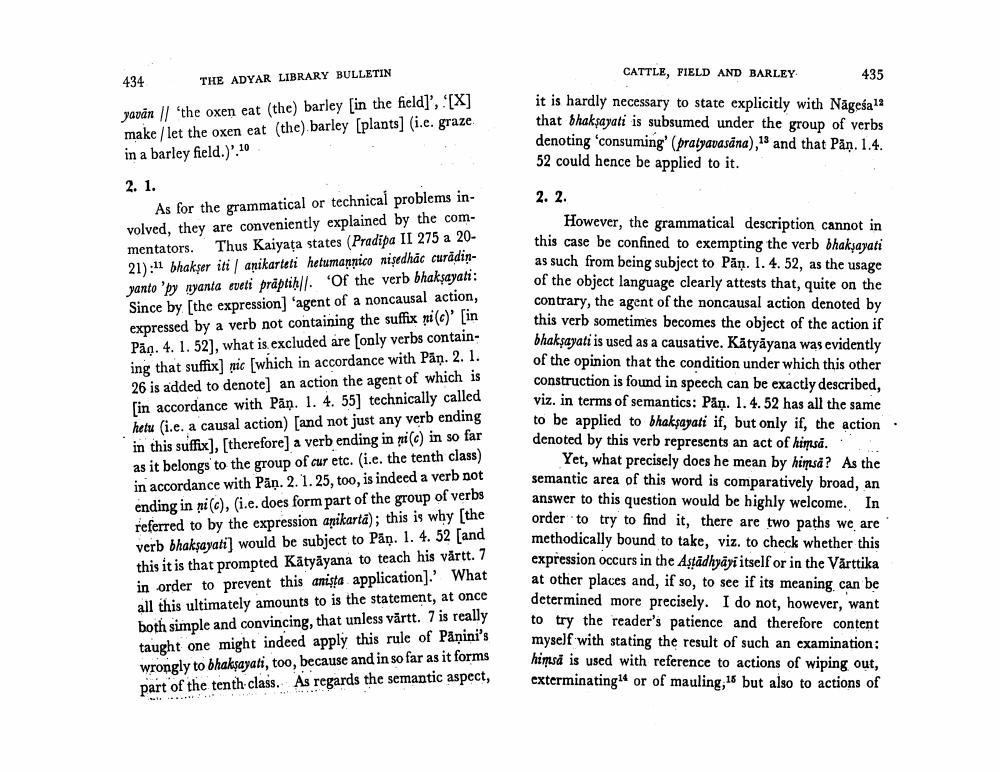Book Title: Cattle Field And Barley Note On Mahabhasya Author(s): A Wezler Publisher: A Wezler View full book textPage 3
________________ 434 THE ADYAR LIBRARY BULLETIN yavan || 'the oxen eat (the) barley [in the field]', [X] make/let the oxen eat (the) barley [plants] (i.e. graze in a barley field.)'.10 2. 1. As for the grammatical or technical problems involved, they are conveniently explained by the commentators. Thus Kaiyața states (Pradipa II 275 a 2021):11 bhakser iti anikarteti hetumannico nisedhac curadinyanto 'py nyanta eveti präptih. Of the verb bhakṣayati: Since by [the expression] 'agent of a noncausal action, expressed by a verb not containing the suffix ni(c)' [in Pag. 4. 1. 52], what is excluded are [only verbs containing that suffix] nic [which in accordance with Pan. 2. 1. 26 is added to denote] an action the agent of which is [in accordance with Pan. 1. 4. 55] technically called hetu (i.e. a causal action) [and not just any verb ending in this suffix], [therefore] a verb ending in ni (c) in so far as it belongs to the group of cur etc. (i.e. the tenth class) in accordance with Pän. 2. 1. 25, too, is indeed a verb not ending in pi(c), (i.e. does form part of the group of verbs referred to by the expression anikarta); this is why [the verb bhakṣayati] would be subject to Pän. 1. 4. 52 [and this it is that prompted Kätyäyana to teach his värtt. 7 in order to prevent this anista application].' What all this ultimately amounts to is the statement, at once both simple and convincing, that unless värtt. 7 is really taught one might indeed apply this rule of Panini's wrongly to bhakṣayati, too, because and in so far as it forms part of the tenth class. As regards the semantic aspect, CATTLE, FIELD AND BARLEY it is hardly necessary to state explicitly with Nageśa12 that bhakṣayati is subsumed under the group of verbs denoting 'consuming' (pratyavasana),13 and that Pan. 1.4. 52 could hence be applied to it. 2.2. 435 However, the grammatical description cannot in this case be confined to exempting the verb bhakṣayati as such from being subject to Pan. 1. 4. 52, as the usage of the object language clearly attests that, quite on the contrary, the agent of the noncausal action denoted by this verb sometimes becomes the object of the action if bhakṣayati is used as a causative. Katyayana was evidently of the opinion that the condition under which this other construction is found in speech can be exactly described, viz. in terms of semantics: Pan. 1. 4. 52 has all the same to be applied to bhakşayati if, but only if, the action. denoted by this verb represents an act of himsă. Yet, what precisely does he mean by himsă? As the semantic area of this word is comparatively broad, an answer to this question would be highly welcome. In order to try to find it, there are two paths we are methodically bound to take, viz. to check whether this expression occurs in the Astadhyayi itself or in the Värttika at other places and, if so, to see if its meaning can be determined more precisely. I do not, however, want to try the reader's patience and therefore content myself with stating the result of such an examination: himsä is used with reference to actions of wiping out, exterminating or of mauling, 15 but also to actions ofPage Navigation
1 2 3 4 5 6 7 8 9 10 11 12 13 14 15 16 17 18 19 20 21 22 23 24
